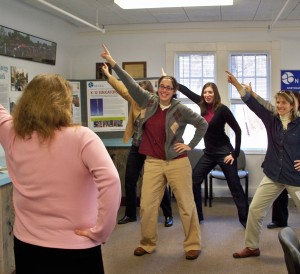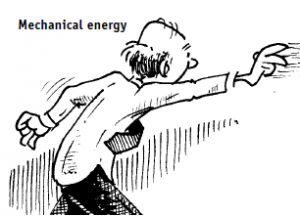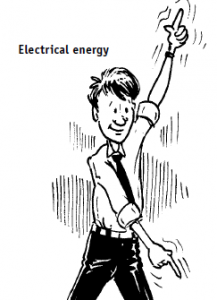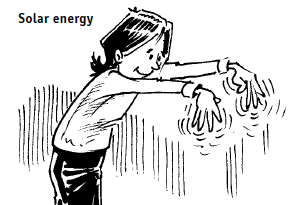Acting Out Energy Forms

Originally appears in the Winter 2009-2010 issue
Lighting homes, heating water, warming spaces, running machines, driving cars and flying planes —everything we do requires energy. In a most basic sense, energy is a force capable of performing work or of organizing or changing matter. But how do we teach about it this invisible force? “Acting Out Energy Forms” is an engaging pantomime activity that helps provide a context for teaching scientific principles related to energy transformations, chemical transformations, electricity and light, which are central to many clean energy technologies. Using pantomime is a fun and effective way to teach if you are comfortable having your students out of their chairs and getting a bit riled up. Active learning helps students comprehend complex ideas. They may not remember the term “kinetic energy,” but once they have acted it out they will remember that energy can be in motion.
For younger students you may decide to introduce energy as a basic concept and pick just a few energy forms to pantomime. For older students you may decide to use this activity as a template to teach the concepts and then have your students create or construct representations of various energy forms as artistic expression pieces or physical science displays.
In addition to introducing students to energy forms, this activity can be used as a stepping stone to larger, interdisciplinary topics such as human impacts on energy supply and demand, global climate change, current and future life styles, sustainability practices, distributed power generation and innovative energy technologies.
Background: Energy forms and sources
Energy occurs in many forms and is classified as either kinetic energy (in motion) or potential energy (stored) and can be converted from one form to another.
Kinetic energy
- Electrical energy is the movement of electric charges. Electricity, which is the movement of electrons through a wire or other conductor, is an example of electrical energy. Lightning is another example.
- Mechanical energy is the movement of objects or matter. Throwing a ball, lifting a weight, pulling a wagon and pedaling a bike are all examples of mechanical energy. Wind and moving water are also examples of mechanical energy. Sound, which is the movement of molecules in a wave, is another example of mechanical energy.
- Radiant or light energy travels in electromagnetic waves. It includes visible light, which our eyes can see, and also gamma rays, x-rays, ultraviolet radiation, infrared (heat) radiation, microwaves and radio waves. Sunlight is an example of radiant energy.
- Thermal (heat) energy is the vibration and movement of atoms and molecules within a substance. The hotter a material is, the faster the atoms and molecules that make up that material are moving.
Potential energy
- Chemical energy is energy stored in the bonds that hold molecules together. Food, batteries, fossil fuels and biomass (plants) are examples of items that have stored chemical energy.
- Stored mechanical energy or elastic energy is energy stored in objects that are either compressed or stretched. Stretched rubber bands or compressed springs are examples of stored mechanical energy.
- Magnetic energy is energy produced by the magnetic field that causes magnets to attract or repel.
- Nuclear energy is the energy that holds the nucleus of an atom together. This energy is released when nuclei are split apart (called fission) or combined (called fusion). Nuclear power plants split atoms to release energy. The sun releases energy when it combines hydrogen atoms to form a helium atom.
- Potential energy or gravitational energy is the energy of position. An object has potential energy when it is in a position to be acted upon by gravity. Water stored behind a dam is an example of potential energy. A book teetering on a bookshelf is another example.
Energy resources
Energy resources are natural resources that can be extracted or captured for the energy they contain. Crude oil, coal, sunlight and wind are all examples of energy sources. Renewable energy sources, such as wind, sunlight, plants and moving water, are those that are naturally and continually replenished. Compared to non-renewable energy sources, such as fossil fuels, renewable energy sources are more sustainable and less damaging to the health of organisms and to the environment on which life depends. “Green energy” is energy obtained from renewable resources that produce little or no pollution and that replenish themselves faster than humans consume them.
Acting out Energy Forms
Objectives:
- Students learn that there are several forms of energy.
- Students are introduced to scientific principles related to energy transformations, electricity and light.
Grade-level: K-8
Procedure:
- Discuss the topic of energy with your students, referring to the background information provided above.
- Choose an open area large enough to facilitate moving about. Introduce the activity by telling students that, “to will learn a little bit about how energy works in our lives, we are going to act out the various forms of energy.” Explain that they will need to listen and watch, because this is a repeat-after-me, do-as-I-do game.
- Using the “Acting Out Energy Forms” activity reference sheet (see page XX), have students mimic you as you act out energy forms. After many chuckles, inquire what knowledge your students retained. Challenge them to state or act out each energy form’s definition.
- For classes that keep science journals, have students write the definition, as they remember it, of each energy form and draw a representational image the definition.
The Northeast Sustainable Energy Association (NESEA)
Focuses on promoting the understanding, development and adoption of energy conservation and non-polluting, renewable energy technologies. The NESEA K-12 Education Department offers professional development opportunities and resources for teachers, non-formal educators, and community mentors, and curriculum and programs on energy efficiency and energy conservation, and on forms and applications of renewable energy. Visit www.nesea.org or call (413) 774-6051.
Acting Out Energy Forms
Leader’s Reference Sheet
Example: The leader says, “Kinetic energy” (students repeat) “is energy” (students repeat) “in motion” (students repeat). The leader pretends to power walk, and the students mimic the action.
- Kinetic energy is energy in motion (pretend to power walk).
- Mechanical energy is energy that is a moving object (pretend to throw a ball).
- Electrical energy is energy that is electrons moving through wires (put hands at sides and shuffle fast a few paces, turn and continue to shuffle, as if you are moving inside a wire). Electrical energy is also lightning! (Pose with your hand raised at a diagonal, finger pointed up to the sky and then point down across your body to the ground. Repeat a few times. Think disco dancing.)
- Radiant energy is the energy of electromagnetic waves, or light, traveling from the sun (splay fingers, pointing slightly down and move your arms in a downward wave
 motion, mimicking sunrays traveling to Earth).
motion, mimicking sunrays traveling to Earth).
- Thermal energy is energy that is vibrating due to heat (jiggle up and down slightly). The hotter the matter gets, the faster it moves (jiggle body up and down faster).
- Potential energy is energy that is waiting (tap your foot and look at your wrist).
- Chemical energy is energy stored in food (pretend to pick up a treat and smack your lips), in batteries (pretend to hold a battery up examining it), in fossil fuels (squat into a ball like a lump of coal), and in plants (feet and legs together, arms out like leaves, head arced to sunlight).
- Elastic energy is energy stored in an object that is either compressed (tighten up your body) or stretched (stretch your body out like a rubber band).
- Magnetic energy is energy created by a magnetic field (pretend your hands are magnets attracting and repelling).

- Nuclear energy is energy that holds the nucleus of an atom together (pretend to hold something small in your hands). Energy is released when nuclei are split apart (pretend to pull something apart between your hands) or forced together (clap your hands once).
- Gravitational energy is energy in a position to be acted upon by gravity (look down and teeter on your feet, as if you are about to fall — be dramatic with hands waving, body bobbing).
- Renewable Energy is energy from sources that are naturally and continually replenished.
- Solar energy is energy that comes from the sun (splay fingers, pointing slightly down and move your arms in a downward wave motion, mimicking sunrays traveling to Earth). The sun’s rays touch the solar panel and the energy inside gets excited (dance in place) and makes electricity (diagonally hand dance up and down).

- Wind energy is energy that comes from wind turning big metal turbine blades in the sky (wave your arms in big slow circles and make a low and constant “whoosh” sound).
- Water power is energy that comes from moving water (move hands in wave-like motion) falling down on turbine blades and turning them (bend over sideways as if falling and spinning your arms).
Download the PDF here.
If you are not already a subscriber, please subscribe to read the full article
Arianna Alexsandra Grindrod is the Education Director at the Northeast Sustainable Energy Association in Greenfield, Massachusetts. She created the “Acting Out Energy Forms” activity for the Northeast Sustainable Energy Association’s teacher-training series Energy Thinking.
Leave a Reply
You must be logged in to post a comment.





